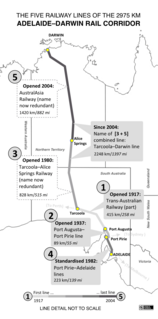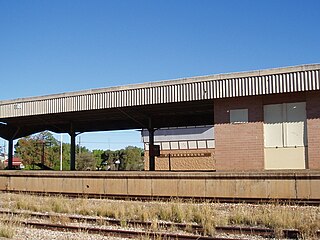
The Adelaide–Darwin rail corridor is a 2,975 kilometres (1,849 mi) series of south–north transcontinental railway lines in Australia, between the cities of Adelaide and Darwin. Built in stages in the twentieth century, the corridor was completed in 2004 when the Alice Springs to Darwin line opened. The corridor is used by The Ghan passenger train and freight trains operated by One Rail Australia.

The Indian Pacific is an Australian experiential tourism passenger train that operates between Sydney, on the Pacific Ocean coast, and Perth, on the Indian Ocean coast. It is one of the few truly transcontinental trains in the world. It first ran in February 1970 after the completion of gauge conversion projects in South Australia and Western Australia, enabling for the first time a cross-continental rail journey that did not have a break of gauge.

Rail transport in Australia is a component of the Australian transport system. It is to a large extent state-based. As of 2018, the Australian rail network consisted of a total of 36,064 kilometres (22,409 mi) of track built to three major track gauges: it had 14,814 kilometres (9,205 mi) of standard gauge ), 15,625 kilometres (9,709 mi) of broad gauge, and 4,225 kilometres (2,625 mi) of narrow gauge lines. Additionally, about 1,400 kilometres (870 mi) of 610 mm / 2 ft gauge lines support the sugar-cane industry.

The Australian state of New South Wales has an extensive network of railways, which were integral to the growth and development of the state. The vast majority of railway lines were government built and operated, but there were also several private railways, some of which operate to this day.

Australians generally assumed in the 1850s that railways would be built by the private sector. Private companies built railways in the then colonies of Victoria, opened in 1854, and New South Wales, where the company was taken over by the government before completion in 1855, due to bankruptcy. South Australia's railways were government owned from the beginning, including a horse-drawn line opened in 1854 and a steam-powered line opened in 1856. In Victoria, the private railways were soon found not to be financially viable, and existing rail networks and their expansion was taken over by the colony. Government ownership also enabled railways to be built to promote development, even if not apparently viable in strictly financial terms. The railway systems spread from the colonial capitals, except in cases where geography dictated a choice of an alternate port.

The first railway in colonial South Australia was a horse-drawn tramway from the port of Goolwa on the Murray River to an ocean harbour at Port Elliot in 1854. Today the state has 1,600 mm broad gauge suburban railways in Adelaide, a number of country freight lines, as well as key 1,435 mm standard gauge links to other states.

The Australian Rail Track Corporation (ARTC) is a Government of Australia owned statutory corporation, established in July 1998, that manages most of Australia's interstate rail network.

The Australian National Railways Commission was an agency of the Government of Australia that was a railway operator between 1975 and 1998. It traded as Australian National Railways (ANR) in its early years, before being rebranded as Australian National.

Rail gauges in Australia display significant variations, which has presented an extremely difficult problem for rail transport on the Australian continent for over 150 years. As of 2014, there are 11,801 kilometres (7,333 mi) of narrow-gauge railways, 17,381 kilometres (10,800 mi) of standard gauge railways and 3,221 kilometres (2,001 mi) of broad gauge railways.

Southern & Silverton Rail was an Australian rail operator. Founded in 1886 as the Silverton Tramway Company, it operated the Silverton Tramway until 1970, before diversifying into operating hook and pull services, being renamed Silverton Rail in the mid-1990s. In 2006 it was purchased by South Spur Rail Services and rebranded as Southern & Silverton Rail, before both were sold to Coote Industrial. In June 2010 it was sold to Qube Logistics and rebranded.

The Broken Hill railway line is now part of the transcontinental railway from Sydney to Perth.

One Rail Australia is an Australian rail freight operator company. Founded by Genesee & Wyoming in 1997 as Australian Southern Railroad, and later renamed Genesee & Wyoming Australia, it was renamed One Rail Australia in February 2020. It is owned by PGGM (51%) and Macquarie Infrastructure & Real Assets (49%).

The Silverton Tramway was a 58-kilometre-long 1,067 mm railway line running from Cockburn on the South Australian state border to Broken Hill in New South Wales. Operating between 1888 and 1970, it served the mines in Broken Hill, and formed the link between the 1,435 mmstandard gauge New South Wales Government Railways and the narrow gauge South Australian Railways lines. It was owned and operated by the Silverton Tramway Company (STC).

Australia's east–west rail corridor is a standard-gauge line that runs for 4,352 kilometres (2,704 mi) across Australia from Sydney, New South Wales, to Perth, Western Australia.
The Adelaide-Port Augusta railway line is the primary rail corridor in South Australia for northbound rail traffic out of Adelaide. The line forms part of the Perth–Adelaide and Adelaide–Darwin rail route, and the portion south of Crystal Brook forms part of the Adelaide–Sydney rail route.

The 500 class were a class of diesel locomotives built by Islington Railway Workshops for the South Australian Railways between 1951 and 1953 using English Electric traction equipment.
The Silverton Tramway 48s class are a class of diesel locomotives built by AE Goodwin, Auburn for the Silverton Tramway in 1960-1961. The State Rail Authority 48 class and South Australian Railways 830 class are of a very similar design.

Peterborough railway station is located on the Crystal Brook-Broken Hill line in Peterborough, South Australia.

Gladstone railway station is located on the Crystal Brook-Broken Hill line in Gladstone, South Australia.

Coonamia railway station was a "provisional stopping place" in the rural locality of the same name, 5.0 km (3.1 mi) by rail south-east of the centre of the city of Port Pirie, South Australia. It was operational for two separate periods:


















